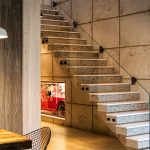A Polish home that’s split right down the middle, this forest home is the perfect blend of rustic simplicity and luxe living
Borowiec is a village within the Polish city of Poznań. With a small but mighty population of just over 1600, the town is all about a slower pace of life away from the city. Architects Jerzy Wozniak and Pawel Garus from mode:lina architekci were called on board to design a home for a family of four who wanted to live separately yet together under the same roof.
Before the homeowners engaged the expertise of mode:lina, they secured a vacant plot of land on the edge of a forest. The brief for the project centred on the idea of having a kid’s zone and an adult’s zone, so every member of the family had plenty of space for themselves. “The parents and two children wanted to live independently, hence the idea of dividing the house into two parts,” says Pawel. “The separate area on the first floor allows the adults to enjoy tranquillity, while the kids can go crazy in their ‘own house’.”
As they were starting from scratch, the architects were able to include every room you could want in a family home and tick all the boxes for the owners. The body of work included a living room, kitchen, dining room, pantry, garage, den, office, wardrobe, two bedrooms and three bathrooms. To ensure peace and quiet, the architects designed the street-facing façade to have the least amount of windows and protect the homeowners from noise. “In addition, various kinds of fences give them a sense of security,” says Jerzy. “That’s where the house got its name from — the Fence House.”
Although inspired by the humble form of the traditional home, the residence is also contemporary and forward-thinking in nature. Comprising two blocks with a sloping roof and an asymmetric garage cube, the home is made up of raw materials including bricks, concrete and sheet in soothing shades of grey. “The project is very consistent,” says Pawel. “It worked well to combine different features that intermingle with each other, and with the garden and adjoining forest.”
In spite of its monochrome exterior, the home’s interior is chock-full of character. Of note is the display under the staircase of the owner’s red classic car, which is exhibited as a piece of art. “It was one of the first elements of the project,” says Jerzy. “The owner loves classic cars, and we offered to expose it in a frame like a painting.”
The kitchen and dining area is open in nature and relies on the timber found in the furnishings and cabinetry to provide warmth to the neutral space. “Much of the furniture was made from 100-year-old wood, which the owner purchased during the reconstruction of one of Poznan’s houses,” says Jerzy. Black and white pendants bring a sculptural element to the space and due to the generous glass windows and sliding doors, the home is flooded with natural light and scenic views of the surrounding greenery. The kid’s wing of the house is the stuff childhood dreams are made of. Timber beams frame the ceiling above the two childrens’ beds, each encased by a timber board in the shape of a house. The tiny houses are kitted out with reading lamps and rectangular cut-outs, ensuring plenty of air flow.
A credit to its cabin-like aesthetic, the Fence House seamlessly fits into its forest location. Addressing the needsof not only the adults but the kids, too, this residence is an
all-rounder when it comes to the humble family home.
For more information
Written by Annabelle Cloros
Photography by Marcin Ratajczak
Originally in Home Design Magazine Volume 20 Issue 3





























